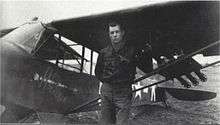Charles Carpenter (lieutenant colonel)
| Charles Carpenter | |
|---|---|
|
Charles Carpenter and his L-4 Grasshopper, mounting a trio of bazookas just outboard of the jury struts | |
| Born |
August 29, 1912 Edgington, Illinois |
| Died |
March 22, 1966 Champaign, Illinois |
| Resting place | Edgington Cemetery, Illinois. |
| Nationality | American |
| Occupation | High-school history teacher |
|
Military career | |
| Nickname(s) | Bazooka Charlie |
| Allegiance |
|
| Service/branch |
|
| Years of service | 1942–1945 |
| Rank | Lieutenant Colonel |
| Battles/wars | World War II |
Lt. Col. Charles Carpenter, aka Bazooka Charlie, (1913 – 1966) was a U.S. Army officer and army observation pilot who served in World War II. He is best remembered for destroying several enemy armored vehicles in his bazooka-equipped L-4 Grasshopper light observation aircraft[1]
Early life and career
Carpenter was born and raised in the town of Edgington, Illinois. After graduation from college, Carpenter took a job teaching history.
World War II service
Carpenter joined the Army in 1942. After completing flight training and receiving his artillery liaison wings, Carpenter flew light observation aircraft such as the L-4 Grasshopper (Piper Cub) and the Stinson L-5 Sentinel.
Upon arriving in France in 1944, Carpenter was assigned an L-4 for artillery support and reconnaissance missions. With a 150-pound pilot and no radio aboard, the L-4H had a combined cargo and passenger weight capacity of approximately 232 pounds.[2][3]
Inspired by other L-4 pilots who had installed bazookas as anti-tank armament on their planes, Carpenter added bazooka launchers to his plane as well.[3][4][5]
Within a few weeks, Carpenter was credited with knocking out a German armored car and four tanks.[5] Carpenter's plane was known as "Rosie the Rocketer", and his exploits were soon featured in numerous press accounts, including Stars and Stripes, the Associated Press, Popular Science, the New York Sun, and Liberty Magazine. Carpenter once told a reporter that his idea of fighting a war was to "attack, attack and then attack again."[6]
After destroying his fifth enemy tank, Carpenter told a Stars and Stripes correspondent that the "word must be getting around to watch out for Cubs with bazookas on them. Every time I show up now they shoot with everything they have. They never used to bother Cubs. Bazookas must be bothering them a bit."[7][8]
By war's end, Major Carpenter had destroyed or immobilized several German armored cars and tanks (he would be officially credited with six tanks destroyed).[5] He was awarded several medals for his actions.
Postwar service
In 1945, Carpenter became seriously ill, and was honorably discharged from U.S. Army service in 1946. He returned to work as a history teacher at Urbana High School in Urbana, Illinois, where he worked until his death in 1966 at the age of 53.[9] Lt. Col Carpenter's remains are buried at Edgington Cemetery, in Illinois.
References
- ↑ Gallagher, Wes, Charlie Fights Nazi Tanks in Cub Armed With Bazookas, The New York Sun, 2 October 1944
- ↑ Piper Cub Weight & Balance Calculation, retrieved 24 October 2011
- 1 2 Fountain, Paul, The Maytag Messerschmitts, Flying Magazine, March 1945, p. 90
- ↑ Francis, Devon E., Mr. Piper and His Cubs, Iowa State University Press, ISBN 0-8138-1250-X, 9780813812502 (1973), p. 117
- 1 2 3 What's New in Aviation: Piper Cub Tank Buster, Popular Science, Vol. 146 No. 2 (February 1945) p. 84
- ↑ Gallagher, Wes, Major Charles Carpenter, Once History Teacher, Now Legend in Patton's Army, The Rock Island Argus, 26 September 1944
- ↑ The Stars and Stripes, Western Europe ed., Nancy Sector (France), (September 20–30, 1944)
- ↑ Bazooka Charlie Becomes Tank Ace Today, Prescott Evening Courier, 11 October 1944, p. 2, retrieved 23 February 2015 from Google Books
- ↑ In Memoriam, Urbana High School Class of 1962, retrieved 23 October 2011
